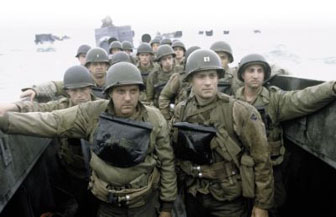Selling Out
By Tom Macy
December 10, 2009
You might respond by saying the movie-going public dictated this uneven schedule. By gravitating to escapist fare in the carefree days of summer and morose in the brooding winter months, Hollywood began releasing films adhering to the buyers' demands. Well, to that I say phooey! True, Transformers is to a day at the beach as Schindler's List is to a shoeless walk in a blizzard, but the reason for such segregation has nothing to do with what the public wants.
Once upon a time, there was a much more even keel look to the release schedule. But that all began to change in the late '70s when two films, Jaws and Star Wars, met, fell in love and gave birth to a beautiful new species, the Blockbuster. It was a child with so much promise that, tragically, in the end it was exploited for evil. The Blockbuster is basically the Anakin Skywalker of movie history.
The tentpole film – a film that appealed universally to the public - quickly became a cornerstone of mainstream movie making. Studios were salivating for their own Star Wars and if they didn't have one, they tried to convince everyone that they did. This brought forth a major shift in marketing. A broader approach was taken. A wider net was cast. With the heightened awareness, anticipation for upcoming films started to become the subject of national conversation. Couple this with rising theater counts that had movies literally opening everywhere – hence the term "In theaters everywhere!" – films began to haul in more of cash up front, often in their first weekend alone. This was most true with sequels, which came with the phrase that's music to a Hollywood exec's ears - the built in audience. All that was left to do was fan the fire.
This trend took shape throughout the '80s, with Return of the Jedi, Indiana Jones and the Temple of Doom and Rambo: First Blood II taking in over $20 million in their opening weekends in consecutive years – the only films in those three years to do so. But the real turning point took place within a month of 1989. During this 30-day period the record for highest opening weekend was broken three times. It began on Memorial Day when Indiana Jones and the Last Crusade opened to $29,355,021, only to be narrowly bested by Ghostbusters II's $29,472,894 3 weeks later. GB II was also one of the first examples of frontloading as it only made $112 million domestically, less than half of the original (whatever, I was six and it blew my mind). But the following weekend of June 23rd was the one that changed everything when Batman, the one with Beetlejuice, opened to a whopping $40,489,746.
Once studios saw the potential to make this kind of money this fast the floodgates were truly opened. Why worry about making a film good - so people would tell their friends to see it – when you can get everyone to go before they hear how crappy it is? Marketing was the game now. And for Hollywood, it was fun to play. Opening weekends soared, from Jurassic Park ‘s $47 million in '93 to Spider-Man's then ridiculous $114 mil in 2002.
Continued:
1
2
3
4
|
|
|
|




